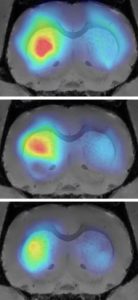 Featured Paper of the Month – February 2020.
Featured Paper of the Month – February 2020.
Designer Receptors Exclusively Activated by Designer Drugs (DREADDs) are a popular chemogenetic technology for manipulation of neuronal activity in uninstrumented awake animals with potential for human applications as well. The prototypical DREADD agonist clozapine N-oxide (CNO) lacks brain entry and converts to clozapine, making it difficult to apply in basic and translational applications. Here we report the development of two novel DREADD agonists, JHU37152 and JHU37160, and the first dedicated 18F positron emission tomography (PET) DREADD radiotracer, [18F]JHU37107. We show that JHU37152 and JHU37160 exhibit high in vivo DREADD potency. [18F]JHU37107 combined with PET allows for DREADD detection in locally-targeted neurons, and at their long-range projections, enabling noninvasive and longitudinal neuronal projection mapping.
Publication Information
High-potency ligands for DREADD imaging and activation in rodents and monkeys. Journal Article
In: Nat Commun, vol. 10, no. 1, pp. 4627, 2019, ISSN: 2041-1723 (Electronic); 2041-1723 (Linking).
